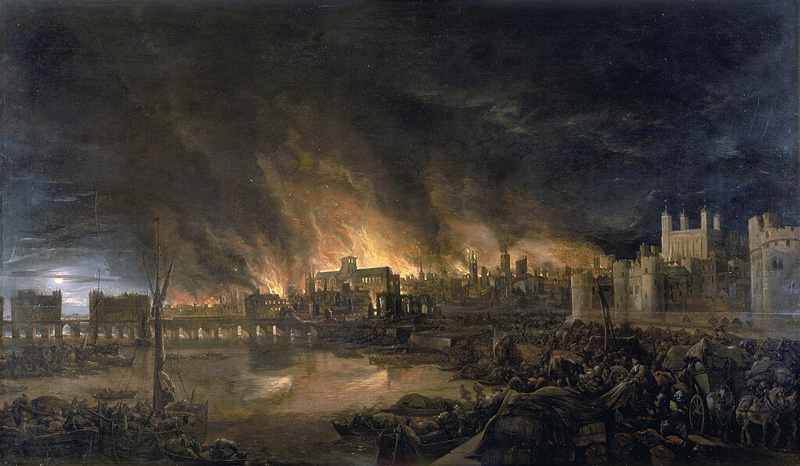 Museum of London
Museum of London Great Fire of London: Experts identify first witness of the deadly event
The Museum of London on Friday announced new research which identifies the first witness of the Great Fire of London as Thomas Dagger, a journeyman baker in Thomas Farriner’s bakery on Pudding Lane.
The research undertaken for the museum’s new site in Smithfield (opening in 2026), was conducted by Professor Kate Loveman at the University of Leicester, who used information from letters, pamphlets, legal and guild records to conclusively find the identity of Thomas Dagger for the first time.
Farriner’s home was the first of 13,200 houses destroyed in the Great Fire, which began on 2 September 1666, 357 years ago this weekend in his bakery, read a press release issued by the Museum of London.
Reports differ on who was in the bakery when the fire started.
A letter from the MP Sir Edward Harley offers the most detailed account.
He wrote that Thomas Farriner’s ‘man’ (meaning his servant or journeyman) was woken after 1am ‘with the choke of the smoke’.
Farriner, his daughter and his man then escaped out of an upper window, but his maid died.
Other sources make no mention of the unnamed man or maid, but refer to Farriner’s son being present.
The information gained from the records provides the surviving members of the Farriner household.
They were Farriner, his adult children Hanna and Thomas, and his ‘man’, who can now be identified for the first time as Thomas Dagger.
It was Dagger who reportedly “discovered” the Great Fire and raised the alarm.
The research will inform galleries at the London Museum in Smithfield, which opens to the public in 2026.
The museum’s popular Great Fire display will be reimagined, putting the stories of real Londoners at the forefront of a newly-designed, interactive space at the new site.
The research was funded by a project, Reimagining the Restoration, which has developed exciting new teaching resources on the Great Fire.
These resources are now available on the Museum of London’s website for teachers and children who want to explore life in the 1660s.
The topic is especially pertinent to Key Stage 1 primary school learners, the majority of whom study the topic as part of the National Curriculum.
A key aspect of these new teaching resources is materials which show children, women, people of colour, and d/Deaf people at the time of the Great Fire of London.
The project aims to give teachers new ways to teach the Great Fire, give learners a sense of place and ownership over their history, and to spark interest in the 17th century.
Kate Loveman, Professor of Early Modern Literature and Culture at the University of Leicester, said: “It was fascinating to find out more about what happened on that famous night. Although most of the evidence about the Farriners is well known to historians, Thomas Dagger’s role has gone unrecognised. Unlike the Farriners, his name didn’t become associated with the fire at the time. Soon after the disaster, he merges back into the usual records of Restoration life, having children and setting up his own bakery. His is a story about the fire, but also about how Londoners recovered.”
Meriel Jeater, Lead Curator for the Museum of London’s new Great Fire displays, said: “This discovery will feed into the exciting new ways in which we’ll be telling the story of the Great Fire of London in the London Museum."
“The museum holds a broad range of items relating to the Great Fire and our aim is to combine these with new research to create an immersive experience which foregrounds historical Londoners using their stories and their own words via letters and diary entries," Meriel Jeater said.
“Our aim is to make the London Museum the best city museum in the world, welcoming millions more visitors than our previous site at London Wall. The Great Fire display will be an integral part of this and our new approach will help us engage more schoolchildren than ever before, as well as ensure that we’re telling the story of the fire in the most accurate and engaging way possible," Jeater said.
Laura Thomson-Turnage, Senior Learning Manager at the Museum of London, said: “We were delighted to work with the University of Leicester on this project and Professor Loveman’s research has enabled us to make our learning resources around the Great Fire of London even more relevant to London’s diverse school population.
“The varied resources we’ve developed include films to be used in the classroom, a comic book resource about d/Deaf Londoners in the 1660s and information packs to support all types of teachers whether they are newly-qualified or very experienced.”
The Reimagining the Restoration project was funded by the Arts and Humanities Research Council.
Support Our Journalism
We cannot do without you.. your contribution supports unbiased journalism
IBNS is not driven by any ism- not wokeism, not racism, not skewed secularism, not hyper right-wing or left liberal ideals, nor by any hardline religious beliefs or hyper nationalism. We want to serve you good old objective news, as they are. We do not judge or preach. We let people decide for themselves. We only try to present factual and well-sourced news.







